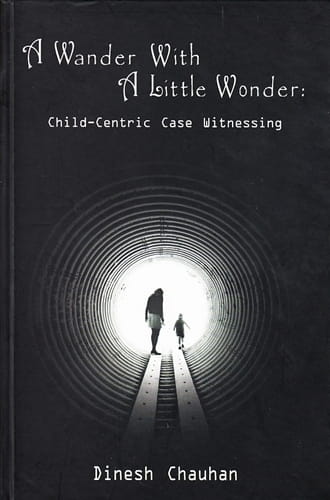Dinesh Chauhan has developed his own art of case taking (Case Witnessing Process) that helps to reach the deepest core of the patient with relative ease. In this book he explores the efficacy of the process in treating children. The first half of the book, Talk the Talk, discusses key ideas and concepts and examines the homeopath's role as a catalyst in case witnessing. The second half, Walk the Talk, presents case examples.
The publisher:
To develop a system of case taking that Dinesh intended to be, ageless, timeless, beyond any personality and more importantly Human Centric, he developed his own Art of Case Taking (Case Witnessing Process) that helps to reach the deepest core of the patient with relative ease.
A Wander with a Little Wonder: Child-Centric Case Witnessing explores the efficacy of the process in treating children. The entire process is completely scientific and reproducible. The first half of the book, Talk the Talk, discusses key ideas and concepts and examines the homeopaths role as a catalyst in case witnessing. The second half, Walk the Talk, presents fascinating case examples.
The entire effort behind this book is to provide A to Z of the Case Witnessing Process (including various techniques that help unearth the difficult cases) that is specialized for each individual child (hence Child-Centric) and which is scientific, easy to follow and reproducible by all.
Dr. Chauhan's scientific approach is applicable not only to children; its universality will be discussed in his forthcoming books - A Journey of the Case Witnessing Process and A Journey after the Simillimum.
- Author: Dinesh Chauhan
- ISBN: 9788184652000
- 268 pages
- Hardback
- Published in 2010
- Printed in India
Reprinted with the permission of The Homeopathic Links Journal, Spring 2011. Reviewed by Kaare Troelsen, Denmark.
One of the best books on homeopathic case taking published for years. Having just had the great fortune to witness Dinesh Chauhan's Case-Witnessing Process (CWP) live, as well as follow his lectures at the Himalayan Sensation Seminar in Naggar, India, I am more than ever convinced that this book is a very important piece of work for classical homeopaths. Dr Chauhan's Case-Witnessing Process is a simple, ingenious, incredibly flexible, powerful as well as subtle method. With this tool the patient will himself lead you to his centre
and reveal the remedy needed. Moreover, by connecting to his centre the awareness
created will start a healing process even before the homeopathic remedy is given. This
CWP method has the potential to create a "like-cures-like" state in the patient by letting him become aware of his inner state and express it in words.
Chauhan's new book demonstrates the use of this method in children's cases, and it is a
joy to read. With one leg solidly planted in the experience of the practical application
of Case Witnessing and the other dancing effortlessly with philosophy, science and
psychology Chauhan has written a book with a truly inspiring scope.
Chauhan starts by reminding us about the "Oh my God!" -reaction many homeopaths
have towards children's cases and proceeds to show us the simple and playful method
of letting the child lead us into the case. We have to become the child, led by another child into the unknown; drop our grown-up attitude and wander about in the wonder of a child's world. This is the simple zen-like way to make a child open up and it is astonishing to see this practised; children at a very young age can really convey to us their unique and rich inner life, if we allow them to and more importantly, allow ourselves to be led there.
The book is divided into three parts; the first part "Talk the Talk" explains the theory that is the basis of this Case-Witnessing Process. In the second part, 'The Womb Connection", Chauhan writes about the connection between the state of the child and state of the mother and foetus during pregnancy; this chapter challenges the existing concept of the mother's state getting transferred to the child, proves it wrong and explores the new possibility which really proves vital while exploring the inner state of a child.
"Walk the Talk" consists of children's cases and is wonderfully illustrated by drawings
made by the kids during Case-Witnessing Process and in follow-ups. The cases are explained and analysed step by step as we wander with the children, deeper and
deeper into their personal worlds. Chauhan explains how to follow the case, when to
listen passively, when to ask open questions and when to draw the patient's attention to
specific areas. It is all done in accordance with the exquisite theory and technique of
tuning into the patient's message in case-taking which Chauhan has worked with for
years.
The illustrative artwork of the book is done by Chauhan's wife Dr Urvi Chauhan and combined with the use of children's drawings this makes the topic come alive in a playful way. The little vignettes of a girl hanging off the page numbers, the stick drawing at the start of each chapter and the clear schematic presentation of the CWP at the end of each case make the learning from this book enjoyable and stimulating.
This book is, however, not just for those who are specifically interested in children's cases, but it is a book that appeals universally to those homeopaths who want to prescribe on more than dry rubrics. It's a book for those for whom case-taking is a thrilling journey of exploration of what it is to be a human being in sickness and health and for those who really want their patient to heal in the wider sense of the word.

